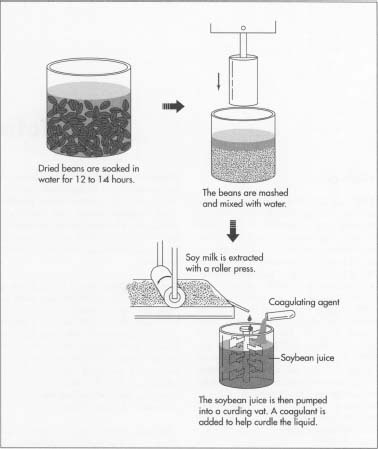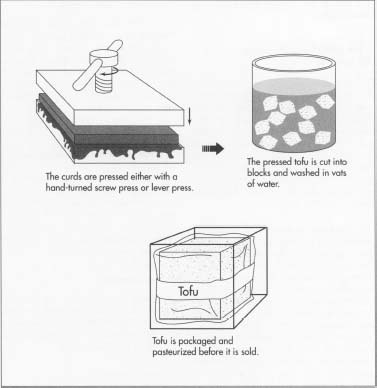Tofu
History
Tofu is a highly versatile and nutritious food that is made from soybean curds. Although the word "tofu" is Japanese, the food seems to have originated in ancient China, where the Mandarin term is "doufu." The creation of tofu is generally attributed to the ruler Liu An of Huai-nan during the second century B.C. The creation of tofu was probably accidental. Although soybeans are not technically a grain, the Chinese considered the soybean one of their essential Five Sacred Grains, along with rice, wheat, barley, and millet. It is likely that Liu An prepared soybeans in much the same way as grains, by drying, mashing, and boiling. The addition of sea salt would not only have seasoned the puree, it would have also acted as a solidifying agent, forming curds. Another theory suggests that the curding process was simply imported from neighboring regions. Regardless, soybeans appear to have been processed into tofu by the second century B.C. using a sea water precipitate to solidify the tofu, a process still used by many manufacturers.
According to ancient text, soybeans were cultivated in northern China at least as early as the 15th century B.C. , during the Chang period. A sixth century Chinese encyclopedia of agriculture, the first of its kind, cites that the explorer Choken brought back soybeans to China from his expeditions to Greece, Rome, and India. However, according to legend, the soya plant was cultivated centuries earlier. In 2838 B.C. , the emperor Sheng-nung wrote a treatise on plants which describes the soya plant in detail. Chinese agricultural experts in 2207 B.C. also wrote about soybean cultivation. Clearly, soybeans were an important staple crop in China for quite some time. The soybean was also recognized for its regenerative properties: the roots of soybeans contain nodules, which discharge nitrogen, and thereby enrich the soil. This important quality made its mark on the old ideogram for the soya plant "su," which contained little lines to symbolize roots.
During the eighth century, Chinese Buddhist missionaries introduced the soya plant to Japan and Korea, although they may have been used there much earlier. Buddhist monks believed that a vegetarian diet was healthier for the spirit so they advocated eating the protein-rich tofu as an alternative to meat. First the upper classes of Japan adopted tofu into their diets and by 1400, during the Muromachi period, tofu was popular among all classes in Japan.
Until about World War II most Japanese and Chinese tofu was made in small family-run shops, each of them using the same ingredients, methods, and tools. In the 1960s, the Japanese Food Research Institute made recommendations for modernizing and standardizing tofu production throughout the nation. Their suggestions included using calcium sulfate as the thickening agent, rather than the natural sea water precipitate, nigari. They also recommended using pressure cookers to speed the process. Hydraulic presses and centrifuges replaced manual lever presses and hand-turned screw presses. Higher speed grinders and aluminum boxes replaced the original wooden boxes. Despite the improvements in efficiency and productivity, many believed that the new methods compromised the flavor of tofu. Traditionalist manufacturers still retain much of the old-style tofu production.

In the U.S., Americans did not readily adopt soybeans into their diet. They were available by the mid-1700s and popularized by Chinese immigrants traveling to California during the Gold Rush of the mid-1800s. As the Chinese immigrants later traveled to other parts of the country, they spread the recipe for tofu. The demand for tofu and other Asian foods also increased after World War II as military personnel returned from Asia, some with Asian spouses. By the 1900s soybeans were grown as a cash crop—primarily for regenerating the soil during crop rotation—as animal feed, and for producing oil and oilcake residue for manufacturing purposes. By the 1950s the U.S. rivaled Asia in its production of soybeans. Forty years later, the U.S. would become the largest soybean producer in the world, providing about two-thirds of the global supply.
During the 1970s, with the growing popularity of ethnic foods in the U.S., mainstream grocers began to offer products like tofu. At the same time, the price of meat soared, and tofu finally caught on as a popular substitute for meat, since tofu is high in protein and low in saturated fat. The increasing health-consciousness of the U.S. populace also contributed to the popularity of tofu. Twenty years later the tofu industry grew to more than a 4-million-pound industry.

The Soybean
The soybean is perfectly balanced in the major food categories of protein, fat, and carbohydrates as well as in vitamins, and minerals. Soybeans also contain an ideal amount and combination of amino acids that are necessary for assimilating nutrients by the human body.
The scientific name for the soybean is Glycine max, and it is part of the botanical family Leguminosae. The soya plant has a slightly woody stalk and reaches a height of 30-36 inches (76-91 cm). The entire plant is covered in greenish hair. The leaves grow in groups of three and fall off as the beans mature. The soya plant produces papilionaceous (butterfly-shaped) flowers that are either white, red, or purple. The pods grow from 1-2 inches (2.5-5 cm) in length, each holding two or three seeds, which become soybeans. Soya seeds are either round or oval and are similar in size to peas. Their color is usually yellow but they may also be green, purple, brown, or a mixture of colors. Soybeans are pulses, that is, the plant has a symbiotic relationship with the bacteria, called rhizobia, that emit nitrogen through nodules in the soya plant's roots.
The soya plant may grow as far north as 52 degrees latitude, even though it is really a sub-tropical plant. Each climate requires slight alterations for growing soybeans, but in general, the beans are sown in the middle of May with heavy machinery. As the beans ripen, the soya leaves fall off. After the short growing period of 15 weeks, only the stalks and pods remain. The plants are harvested mechanically.
The Manufacturing
Process
The ingredients for making tofu are few. They include the milk of soybeans, water, and coagulating agents. The modern tofu manufacturing process is largely an automated version of the traditional method, and much of the modern equipment is made in Japan. While an individual tofu maker might work with 20 gallons (76 1) of beans at a time, a contemporary processing facility can produce about 3.5 tons of tofu per day, using 5.7 tons of soybeans.
The first step in making tofu is soaking the soybeans and extracting the milk. A coagulant is added to curd the milk. Traditionally the coagulant used is nigari, which is a sea water precipitate rich in minerals such as magnesium and calcium chlorides. But modern manufacturers use either calcium sulfate or magnesium chloride. The soya curds are then processed into tofu in the desired form, primarily in custard-like blocks. A variety of textures may be produced, depending on the water content. Tofu comes in soft, firm, and extra-fimn, as well as silken or in liquid form. A number of tofu flavors, such as Jalapeno and Cheddar, are also available.
Soaking the beans
- 1 Dried beans, which come in 60-pound (27 kg) sacks, are soaked in water for 12 to 14 hours. The beans soften as they absorb the water and double in size.
Processing the soybeans
- 2 After soaking, the beans are mashed with special Japanese stone grinders or other pureeing machines and mixed with water into a slurry. The slurry is boiled to neutralize an enzyme that hinders digestion.
- 3 The soy milk is extracted with a roller press, separating it from the pulp, which consists of the hull and fiber. This process may take about two hours to complete. The remaining pulp can be used to feed live-stock.
Solidifying the soy milk
- 4 Once the whey is extracted, the soybean juice is pumped into curding vats. A coagulating agent is mixed in, such as calcium sulfate, magnesium chloride, or nigari. The coagulant alters the pH and curds the milk much like the process for making cottage cheese. This step takes about 20 minutes.
Pressing the tofu
- 5 Traditionally the curds are pressed with hand-turned screw presses or simple lever presses. The tofu may be pressed in cheesecloth-lined boxes. Modern systems use centrifuges or hydraulic presses. The whey drains off, leaving soft blocks of pressed curds. Tofu can be produced in a variety of textures, from a dense cheese-like texture to a softer or liquid form.
Cutting the tofu
- 6 Automated cutters slice the cake tofu into one-pound (.45 kg) blocks. The tofu blocks are washed in vats of water where they firm up and are stored until they are ready to be processed further.
Packaging the tofu
- 7 Tofu may be packaged into shrink-wrapped blocks or continuous thermo-form packages. Water may be added to the packages, or tubs, and then they are sealed, weighed, and dated. Some companies process the soy milk directly in its package.
Pasteurizing the tofu
- 8 The packaged tofu is pasteurized at about 180°F (82°C). Pasteurization extends the shelf life of tofu to about 30 days. The tofu is then chilled in water until it is ready to be placed into boxes and shipped to distributors. Tofu must be refrigerated at below 45°F (7°C) to keep it fresh.
Quality Control
During the 1970s, when tofu was still a fledgling product in the U.S., there were few guidelines regulating the tofu industry. Therefore tofu manufacturers turned to the guidelines set for meat and dairy processors. One of the early complaints about tofu in the U.S. was that it tasted bland, too beany, and astringent. But genetic engineering greatly improved the flavor of the soybeans used for tofu manufacture. Researchers have discovered that the enzyme lipoxygenase causes the off-flavor, and they have been able to breed soybeans with a lower content of lipoxygenase. Another method is to neutralize the undesirable taste by adding flavors to the tofu.
The Future
Technology will continue to improve the flavor and texture of tofu. Dozens of new tofu products enter the market each year and have expanded that segment to more than $100 million in the 1990s. Demand for soybased food products will most likely continue to rise as medical research uncovers the health benefits associated with soybean consumption, namely the prevention and treatment of heart disease and cancer.
Where To Learn More
Book
Toussaint-Samat, Maguelonne. A History of Food, translated from the French by Anthea Bell, Blackwell Reference, 1987 in French, 1992 translation.
Periodicals
Clifford, Carlsen. "Utilitarian Soybean Curd Goes Exotic." San Francisco Business Times, June 28 1991, p. 1.
"Soy: The Bean Most Likely to Succeed in Fending Off Cancer, Heart Disease." Environmental Nutrition, May 1994, p.1.
Gerrietts, Marcie, Linda Cooke, and Marcia Wood. "Soy! It's No Ordinary Bean: Part 2." Agricultural Research, November 1993, p. 10.
Hewitt, Linda. "An Attractive Alternative: Protein from Fungi and Soya." Food Manufacture, May 1994, p. 25.
Kevin, Kitty. "Tofu Comes of Age." Food Processing, June 1994, pp. 81-82.
"Tofu Expands as a Healthy Alternative in American Diets." Supermarket Business Magazine, February 1992, p. 16A.
Wagner, Bill. "Surprising Sources for New Foods." FDA Consumer, November 1993, p. 28.
— Audra Avizienis